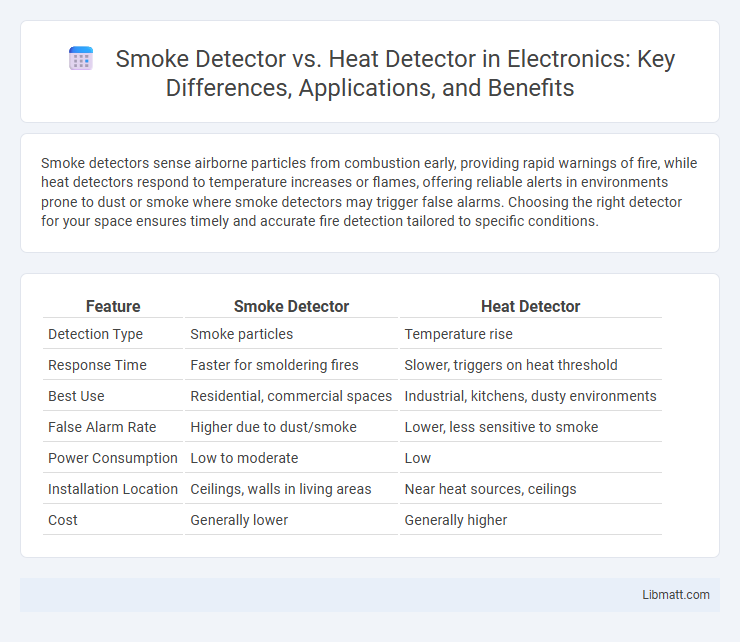Smoke detectors sense airborne particles from combustion early, providing rapid warnings of fire, while heat detectors respond to temperature increases or flames, offering reliable alerts in environments prone to dust or smoke where smoke detectors may trigger false alarms. Choosing the right detector for your space ensures timely and accurate fire detection tailored to specific conditions.
Table of Comparison
| Feature | Smoke Detector | Heat Detector |
|---|---|---|
| Detection Type | Smoke particles | Temperature rise |
| Response Time | Faster for smoldering fires | Slower, triggers on heat threshold |
| Best Use | Residential, commercial spaces | Industrial, kitchens, dusty environments |
| False Alarm Rate | Higher due to dust/smoke | Lower, less sensitive to smoke |
| Power Consumption | Low to moderate | Low |
| Installation Location | Ceilings, walls in living areas | Near heat sources, ceilings |
| Cost | Generally lower | Generally higher |
Introduction to Smoke Detectors and Heat Detectors
Smoke detectors sense airborne particles produced by combustion, triggering alarms when smoke is detected, making them essential for early fire detection in residential and commercial settings. Heat detectors respond to temperature changes or extreme heat levels, providing a reliable alert in environments where smoke detectors may produce false alarms, such as kitchens or dusty areas. Both devices are critical components of comprehensive fire safety systems, each tailored to specific detection needs.
How Smoke Detectors Work
Smoke detectors work by sensing smoke particles in the air, using either ionization or photoelectric technology to detect early signs of fire. Ionization smoke detectors are more responsive to flaming fires with small smoke particles, while photoelectric detectors excel at identifying smoldering fires through larger smoke particles. Your choice between smoke and heat detectors influences how quickly the alarm responds to varying fire conditions.
How Heat Detectors Work
Heat detectors operate by sensing changes in temperature caused by fire or abnormal heat buildup, triggering an alarm when a predefined temperature threshold is reached. Unlike smoke detectors that detect particulate matter, heat detectors use thermal sensors such as fixed temperature or rate-of-rise sensors to monitor heat levels. These devices are effective in environments with high dust, smoke, or steam where smoke detectors may produce false alarms.
Key Differences Between Smoke and Heat Detectors
Smoke detectors sense airborne particles from combustion, providing early warning of smoke presence, while heat detectors respond to a rapid rise in temperature or a fixed temperature threshold. Smoke detectors are more effective in detecting smoldering fires, whereas heat detectors excel in environments with dust, smoke, or steam where false alarms are common. The primary difference lies in their sensing technology: photoelectric or ionization for smoke detectors and thermocouples or thermistors for heat detectors.
Types of Smoke Detectors
Photoelectric and ionization are the two primary types of smoke detectors, each designed to detect different kinds of fires--smoldering and flaming, respectively. Photoelectric detectors use a light source and sensor to identify smoke particles, while ionization detectors use a radioactive source to detect changes in electrical charge caused by smoke. Combination detectors integrate both technologies to provide comprehensive fire detection and enhanced safety.
Types of Heat Detectors
Heat detectors include fixed-temperature, rate-of-rise, and combination types, each designed to respond to specific thermal changes. Fixed-temperature detectors trigger an alarm when the ambient temperature reaches a predetermined threshold, commonly between 135degF and 190degF. Rate-of-rise detectors activate when the temperature increases rapidly, typically at a rate of 15degF to 20degF per minute, making them effective for detecting fast-developing fires.
Applications and Best Use Cases
Smoke detectors excel in residential and commercial buildings where early detection of fire by sensing smoke particles is crucial for safety. Heat detectors are ideal in environments with high dust, steam, or smoke levels, such as kitchens, garages, and industrial settings, where they detect rapid temperature rises or fixed temperature thresholds. Choosing the right device depends on your specific environment's risk factors and sensitivity to false alarms.
Installation and Maintenance Considerations
Smoke detectors require placement on ceilings or high walls away from air vents, while heat detectors are often installed in kitchens or garages where smoke alarms may trigger false alarms. Regular battery replacement and sensitivity testing are essential for smoke detectors, whereas heat detectors need periodic cleaning to remove dust buildup that can affect sensor accuracy. Choosing the right detector based on environmental conditions can optimize Your fire safety and reduce false alarms.
Cost Comparison: Smoke vs Heat Detectors
Smoke detectors generally cost between $15 to $50, making them more affordable for residential use, while heat detectors range from $30 to $70 due to their specialized sensors designed for detecting temperature changes. Your choice in cost will depend on the specific needs of your space, as heat detectors are typically preferred in environments prone to smoke but not fire, such as kitchens or garages. Investing in the appropriate detector helps balance upfront expenses with long-term safety and maintenance costs.
Choosing the Right Detector for Your Property
Smoke detectors offer early warning by sensing airborne particles from combustion, ideal for residential spaces and areas with high fire risk due to smoke. Heat detectors respond to rapid temperature increases or fixed high temperatures, making them suitable for environments prone to dust, steam, or smoke where false alarms are common. Selecting the right detector depends on the specific conditions of your property, such as occupancy type, environmental factors, and fire risk to ensure optimal safety and functionality.
Smoke detector vs Heat detector Infographic

 libmatt.com
libmatt.com